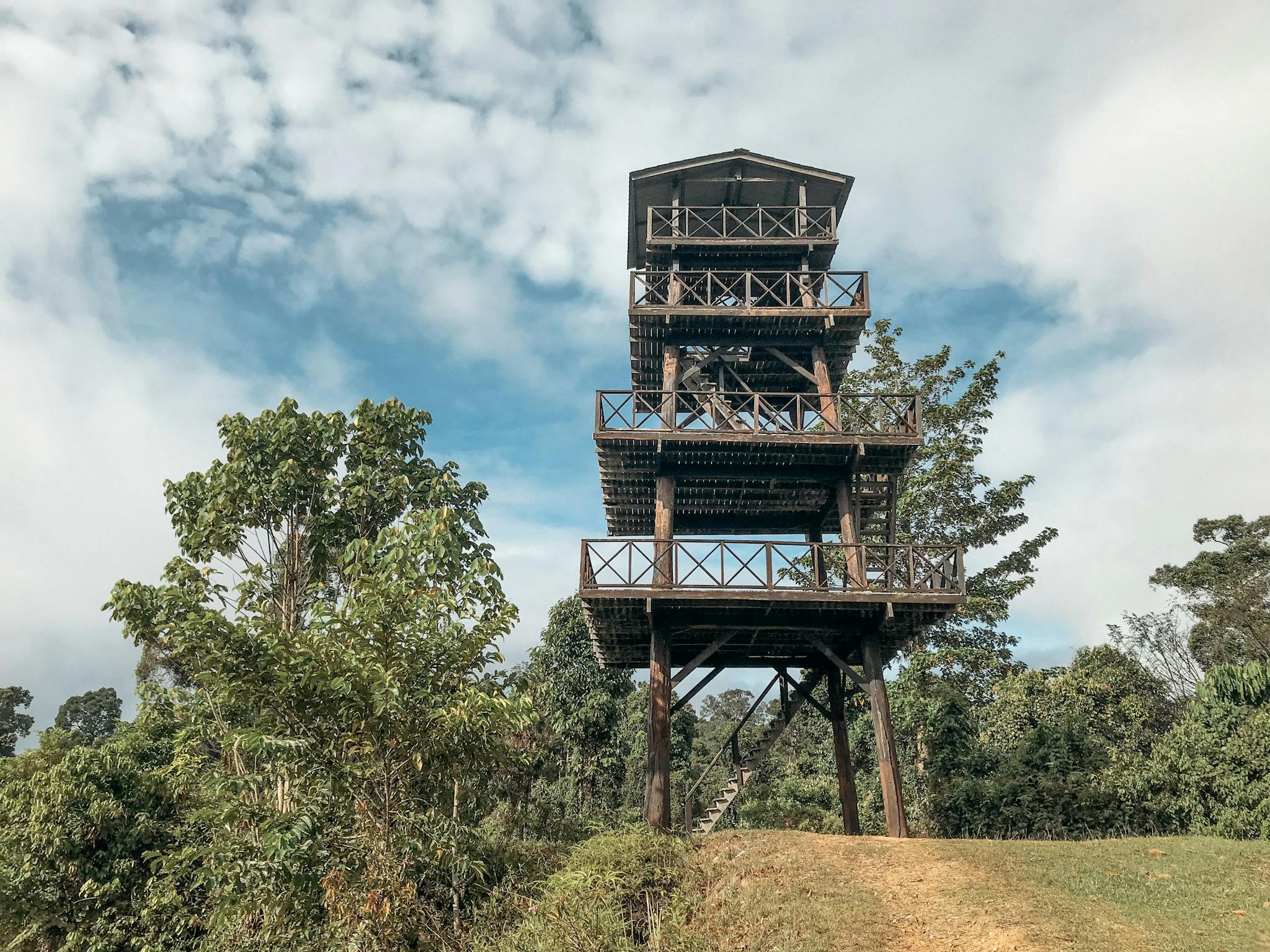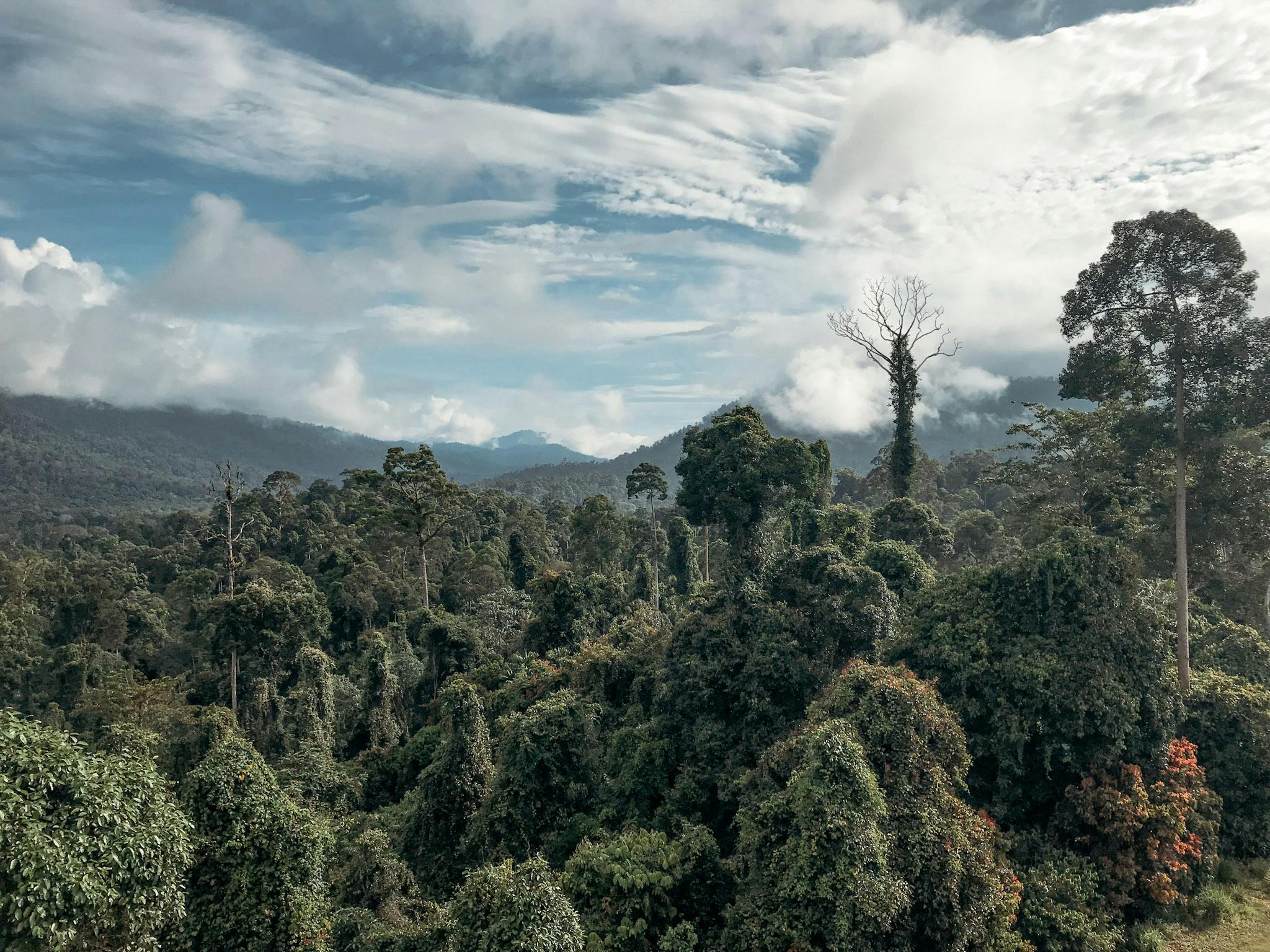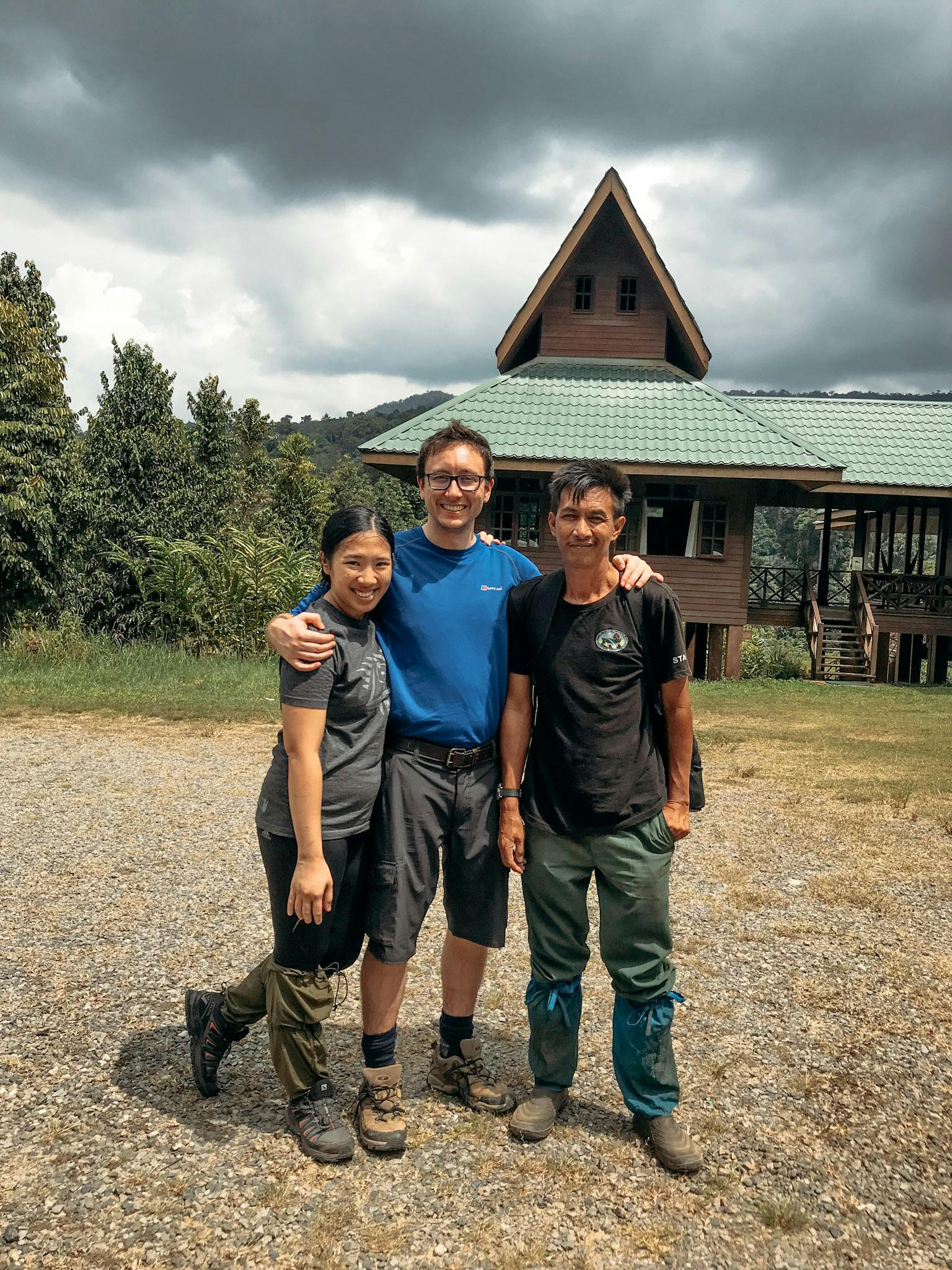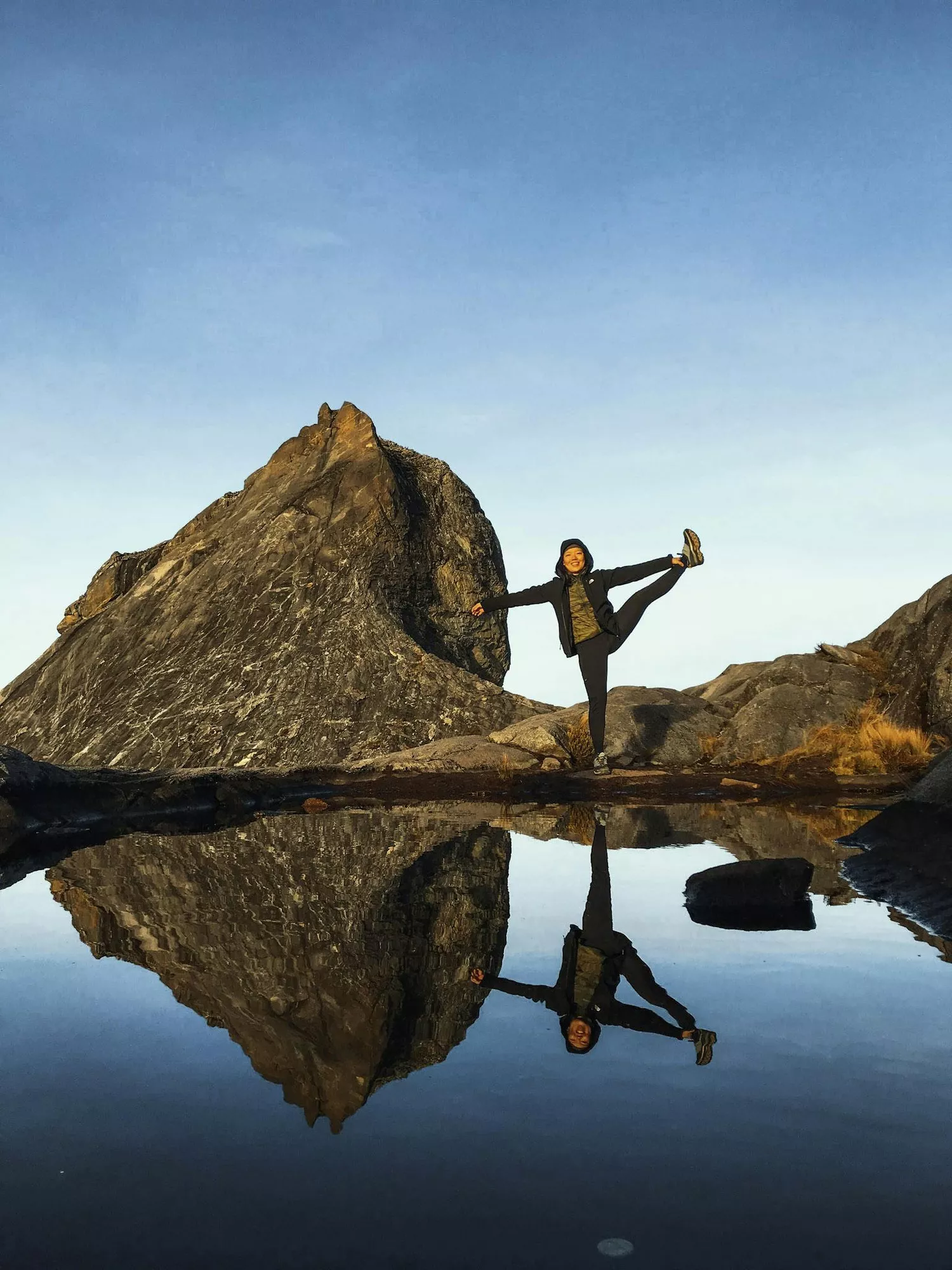探索马辽盆地——地球上最原始的地方
走进沙巴的失落世界

Fitness Level: Beginner to Intermediate
Fly to: Kota Kinabalu
Number of Days: 6 Days (including flights)
Maliau Basin is a 130-million-year-old rainforest that has never been inhabited by humans. This makes it one of the last truly wild places on Earth.
Fun fact - Maliau Basin was only really known to the outside world as recently as 1988 when a full scientific expedition was carried out at the basin. Even then it's estimated that over-50% of the basin remains unexplored, and it could be home to previously-thought extinct species.
The Basics
Why Go

Entering Maliau Basin feels like wandering through a lost world. You'll encounter trees so tall they block out the sunlight, wildlife scampering in all directions, overgrown carnivorous pitcher plants and an ethereal moss that makes you feel like you’re in an enchanted forest.
The basin is home to a diverse range of wildlife, including orangutans, pygmy elephants, and clouded leopards. It is also home to a number of rare and endangered plant species.
The Maliau Basin is a challenging place to visit, but it is also an incredibly rewarding experience. The rainforest is lush and green, and the wildlife is abundant. You can hike into the virgin rainforest, swim in its many waterfalls, or take a safari to see the nocturnal animals.
The Maliau Basin is a special place that is worth protecting. By visiting the basin, you can help to raise awareness of this important ecosystem and contribute to its conservation.
Getting There

The closest international airport to Maliau Basin is Kota Kinabalu, Malaysia. From there, Maliau Basin is approximately a 7-8 hour drive depending on weather conditions. Alternatively, visitors can charter a small plane to the Maliau Basin Airstrip, which is about 20 minutes from the studies centre.
The closest town to Maliau Basin is Tawau, Sabah. From there, it's a four-hour drive to the Maliau Basin Studies Centre.
How to Explore Maliau Basin

You can either stay around the outer rim, Maliau Basin Studies Centre for wildlife spotting, or you can do a trek into Maliau Basin to see the untouched rainforest.
Around Maliau Basin Studies Centre you might see flying squirrels, the clouded leopard and pygmy elephants though the rainforest here is so dense that you are unlikely to see large game here.

Inside Maliau Basin, you can either do a four day trek (3 days of hiking, approximately 27km), or a five day trek into the virgin rainforest (4 days of hiking, approximately 35km in total).
Either trek will take you to the majestic Maliau Falls which is incredibly remote and breathtaking. If you do the longer trek you will also head into the gorgeous Heath Garden where you will be surrounded by gigantic, carnivorous pitcher plants.

If you have the stamina, we'd highly recommend the longer hike because you'll get to see the best of Maliau Basin - and you've already come all this way!
What to See and Do at Maliau Basin
Maliau Basin Studies Centre
Maliau Basin Studies Centre refers to facilities that are built around the rim of the core Maliau Basin Conservation Area. This is a more developed area of huts, jewelled ponds, trees in autumnal shades and wildlife in every direction.

All the trips will include spending some time at Maliau Basin Studies Centre. The hiking trips will include the first night at the Maliau Basin Studies Centre (together with walks and wildlife spotting), and if you don't want to hike you can also spend a couple of nights just at Maliau Basin Studies Centre.
Here, you'll get to do activities like short walks and a night safari. Some of Sabah’s rarest mammals such as the Clouded Leopard, pygmy elephants and the Sumatran Rhino have been found here.

You are unlikely to spot large wildlife here as they'll mainly be hiding in the forested areas, but you'll get to see plenty of wild boar, families of Sambar Deer and flying squirrels leaping from tree to tree.
Fun fact: The Maliau Basin Studies Centre is also home to two resident sunbears who love stealing food. Their favourite food are salted fish, cooking oil and honey!
Regardless of what you end up finding here, a safari in one of the most remote places on earth will be etched in your memory for a long time.
Ginseng Camp

Ginseng Camp is one of the two camps within the main Maliau Basin Conservation Area. Whether you do the short or longer hike, you'll be spending the night at Ginseng Camp.
Ginseng Camp is close-by to the 27m high Ginseng Falls, and the epic 7-tiered Maliau Falls, so from the camp you'll be able to do a couple of short hikes to see both falls.

The other noteworthy thing about Ginseng Camp is that there is a 3km steep stretch of hill on the way to Ginseng Camp that's known to be the hardest stretch of the entire Maliau Basin hike.
The hill bears many names, but the most telling name is Maggi Hill. It got its name when a new ranger found the climb so tough that he threw up his Maggi Mee breakfast on it!
Maliau Falls

The 7-tiered Maliau Falls is one of the highlights of the trip. Here, the tallest tier is almost 10-stories high!
Even though it's only less than 5km hike from Ginseng Camp, it definitely feels further than that as you'll need to navigate ropes, ladders and steep downhill terrain to get there. That's also part of the fun for us because it really feels like exploring unchartered ground.

As you approach the falls, you'll be able to hear its roar from a distance. It’s at the falls when you’ll truly feel immersed in the wilderness of Borneo and experience being in the Lost World.
Nepenthes Camp and the Heath Forest

If you do the longer trek, this will take you to Nepenthes Camp. The Nepenthes Camp offers you the chance to check out a couple of extra waterfalls including Takob Akob Falls and Giluk Falls which you can explore the afternoon you arrive at the camp providing you have time.
There is also an observation platform at the Nepenthes Camp that you can climb to give you a better perspective of the surrounding forest.

The real highlight of Nepenthes Camp is the Heath Forest. When you trek into the Heath Forest, you’ll be surrounded by overgrown carnivorous pitcher plants and an ethereal moss that makes you feel like you’re in an enchanted forest.
This alone is worth doing the longer trek for!
Conservation of Maliau Basin
Many people believe that we should leave off-grid places alone, so that they can be kept pristine. But the truth is, many of these places are protected because of tourism. Maliau Basin is a perfect example of this. It's one of the most important places for conservation on Earth, but because not many people know about it or visit it, it's been under threat of being converted into a coal mine for decades.

By visiting Maliau Basin, we can help to protect it. When we travel there, we are providing crucial tourism dollars that support local communities and sending a signal that it should be protected. Simply by going to Maliau Basin in a responsible way, you can help protect the rainforest.
Ever Present Threat of Coal Mining
For years and years, local authorities have been discussing the possibility of coal mining at Maliau Basin. Each time, these plans have been heavily protested by the local communities, and shelved. While the Sabah state government has recently declared the area protected, the threat still hangs over the area.
The proposed coal mine would be located in the heart of the rainforest, and it would destroy tens of thousands of hectares of forest. The mining would cause a drastic change to the area, but it’s not limited to loss of habitat. Coal mining also has dire consequences such as air and water contamination, severe enough to cause bodily damages to locals who live nearby.
Poaching of Ancient Trees

Another threat to Maliau Basin is tree poaching (yes, tree poaching!). The rainforest is home to agarwood, a tree that is worth a lot more than gold per kg. Agarwood is used to make incense and perfume, and it is in high demand in the Middle East, Europe and many parts of Asia. Have you heard of the scent Oud? That's made with Agarwood.
For years now, Poachers have been illegally cutting down centuries' old Agarwood trees in Maliau Basin. This has led to a decline in the population of Agarwood trees, and it has also damaged the rainforest ecosystem.
Tree poaching is a well-known problem in the Maliau Basin, but it is difficult to monitor such a vast area. The development of the outer rim of the basin through the Maliau Basin Studies Centre was done with the intention of attracting more tourists. The hope is that by having more people in the outer rim of the basin, poachers will be deterred from entering.
How Can We Help

Our first instinct may be to leave untouched off-grid places like Maliau, but the reality is that these places may not exist for much longer if we don't visit them. Governments, corporations, and even locals may find more lucrative ways to use the land, such as coal mining or tree poaching. However, by choosing to travel to Maliau Basin in a responsible way, we can help to protect this rainforest.
Here are some specific ways to travel to Maliau Basin in a responsible way:
- Choose a tour operator that is committed to sustainable tourism (such as the ones here).
- Pack light and avoid bringing single-use plastics.
- Be respectful of the local environment and wildlife.
By supporting sustainable tourism at Maliau Basin, we can give everyone an incentive to protect and conserve the rainforest. Tourism dollars can go a long way to generate revenue for conservation efforts, create sustainable jobs in the local community, and raise more awareness of the importance of the rainforest.
Frequently Asked Questions
How Fit Do I Need to Be to Visit Maliau Basin?

If you choose to stay at the outer rim of Maliau Basin, the Maliau Basin Studies Centre, you don't need to be fit at all. All you'll be doing here is short easy walks, and wildlife spotting on a jeep. This is suitable for young children and the elderly.
If you're hiking into Maliau Basin Conservation Area, you'll be hiking for either three or four days (around 9km each day). The hikes aren't difficult, though you’ll need to be prepared for short spurts of steep climbs, and clambering downhill with rope. It's suitable for anyone who is reasonably fit.
What's the Accommodation Like at Maliau Basin?

All the accommodation here is pretty basic, but it's more basic within the core Maliau Basin Conservation Area as the intention is to keep the core conservation area as untouched as possible.

At Maliau Basin Studies Centre (the outer rim), you'll be able to find huts and basic but comfortable beds in either dorm or private accommodation.
Within the Maliau Basin Conservation Area, there are two camps where you'll sleep in - Ginseng Camp and Nepenthes Camp.

At both of these camps, you'll only find make-shift tin roof structures and very basic bunk beds. Think of the accommodation within the conservation area as a very basic army camp!
Are There Leeches in the Forest?
We didn't find leeches in the Maliau Basin Conservation Area, but encountered plenty of them when we hiked into the main conservation area. Our guide explained that leeches are a common sight in the rainforest, and he even joked that they are the "forest tax collectors." While leeches can be annoying, they are actually a sign of a healthy forest - so having them in Maliau Basin is a good sign!
The number of leeches also depends on the time of year. There are fewer leeches during the dry season, when the ground is drier and the leeches are less active.
Guides in the Maliau Basin Conservation Area usually prepare leech socks for hikers, so you don't need to worry about getting bitten. However, it is always a good idea to check with your guide before you start your hike.
If you do encounter a leech, the easiest way to remove it is to pull it off, roll it into a ball and drop it on the ground. This way, you'll get them off you but won't cause any harm.
常见问题
什么是马辽盆地?它有什么特别之处?
马辽盆地是世界上极少数从未有人类居住过的地区之一。它位于沙巴哥打京那巴鲁以南,车程大约6小时,是一个碗状的区域,被大约390平方公里的原始热带雨林覆盖,四周被高达1600米的陡峭山坡包围。
这里常被称为“沙巴的失落世界”,拥有约58,840公顷的原始森林,有崎岖的山脊、深邃的峡谷和壮观的瀑布。这个地方的生物多样性非常丰富,有超过1,000种动植物生活在这里。这个偏远的区域是在1947年,一架小型飞机差点撞上被雾气笼罩的山脊时才被发现。但当时这个发现并没有引起太大关注,这片区域也就继续沉寂在云雾中。直到1988年,沙巴基金会和马来西亚世界自然基金会组织了全面的科学考察,马辽盆地才开始被世人所知。
即使在亚马逊,也有不少人定居在森林里,有小规模农业、打猎等活动。然而在马辽盆地里,你完全看不到人类活动的痕迹,这也让它在全球都显得特别独一无二。
要怎么去马辽盆地?
想去马辽盆地,首先需要前往沙巴的斗湖。从斗湖出发,开车大约四小时可以抵达马辽盆地研究中心,在那里你可以安排导览行程。离马辽盆地最近的国际机场是哥打京那巴鲁,从机场出发车程大约7到8小时,具体时间取决于天气状况。另一种方式是包机飞到马辽盆地的简易机场,距离研究中心只有20分钟车程。
在马辽盆地可以做哪些活动?
马辽盆地对大自然爱好者来说是个天堂,你可以进行丛林健行、观察野生动物、赏鸟,或在清澈的瀑布中游泳。这里还有一些露营地点,让你能近距离感受大自然。建议选择有导游的行程,确保安全也不打扰自然环境。
你可以选择待在马辽盆地研究中心附近观赏野生动物,比如飞鼠、云豹和侏儒象,不过由于森林非常茂密,大型动物不容易看到。
如果你想更深入探索,可以选择四天或五天的徒步行程,进入原始森林。两个行程都会带你前往壮观又偏远的马辽瀑布。如果你选择五天的路线,还会前往瓶子植物花园,那里满是美丽的猪笼草。
什么时候是去马辽盆地的最佳时间?
最佳的访问时间是每年三月至九月之间的旱季,这段时间雨水较少,步道也比较好走。但需要注意的是,这里是受保护的自然保护区,每次进入的人数有限,所以建议提前预订确保有位子。
为什么马辽盆地对生态保护那么重要?
马辽盆地是地球上极少数未被破坏的自然区域之一,因其独特的生态系统和高度的生物多样性而具有极高的保护价值。这里栖息着许多稀有和濒危的动植物,是科学研究和生态保护的重点地区。
马辽盆地的森林也能吸收大量二氧化碳,帮助减缓气候变化。此外,这里还是多个河流的重要水源地,供养着周边成千上万的居民。
这个保护区也是当地原住民的家园,他们世世代代在这里生活,依靠森林资源维持生计。保护马辽盆地不仅是在守护自然,也是在保护这一地区的文化遗产。
为此,马来西亚政府和多个环保组织一直在通过可持续旅游、科学研究和生态保护项目,共同努力守护马辽盆地,确保这里的独特生态系统能够持续存在下去。








![最佳野生红毛猩猩观赏地 [2025]](https://d18sx48tl6nre5.cloudfront.net/webp_md_26a1e349373ffec8569b965090d516ed.webp)
![最佳野生红毛猩猩观赏地 [2025]](https://d18sx48tl6nre5.cloudfront.net/webp_xl_c672dd74144da152164fa955c08eb6e9.webp)




